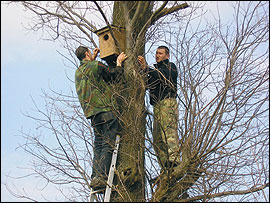Nest-boxes help rollers in Serbia to survive |
 |
Volunteers install a nest box in trees close to favourable feeding sites for the Eurasian roller, whose habitat has been lost to agriculture intensification. |
The colourful Eurasian roller, with its brown back and blue shoulders, has recently experienced a ra-pid population decline. Once a common breeder in plains and low hills throughout Serbia, the roller has become one of the most endangered species during the last decade.
Just 65 to 80 pairs breed in the country currently, mainly in the north-east. Severe habitat loss has brought about their recent decline: the birds nest in hollow cavities of trees and need extensively used pastures, which have been lost to agriculture intensification.
Active conservation has proven to be useful in safegu-arding existing populations. Since 2003, Riparia As-sociation of Naturalist and Bird Protection and Study Society of Vojvodina have installed 39 wooden nest boxes in Selevenjske Pustare nature reserve, Huboti-ca-Horgos Sands, and in north Banat.
The nest boxes have been built in trees close to favourable
feeding sites, and the outcome has been very encouraging: between 30% and 90% of the boxes have been occupied during the breeding season. "Roller protection, which was supported in 2005 by the provincial
Secretariat for Environmental Protection and Sustainable Development, needs to be internationally funded," says Boris Hardi, president of Riparia, "as this is a high-priority species of European conservation
concern."